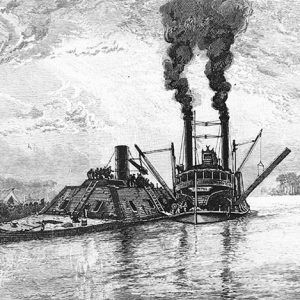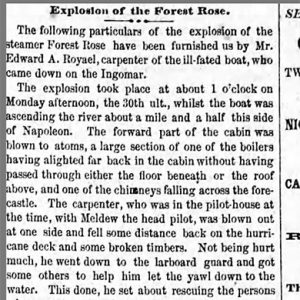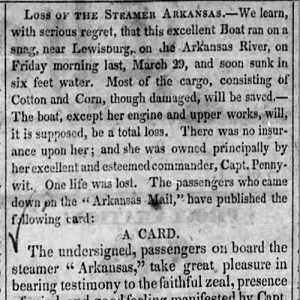calsfoundation@cals.org
Steamboats Named Arkansas
At least twenty nineteenth-century steamboats were called Arkansas or a derivative of the state’s name, according to information in the Herman T. Pott National Inland Waterways Library at the University of Missouri–St. Louis and Way’s Packet Directory. One of these steamboats famously sank on state waters in 1844.
The earliest known Arkansas was a sidewheel steamboat built in 1818. Little is known about it, but the Arkansas Gazette wrote about it on December 29, 1821, in an article about four companies of the U.S. Seventh Infantry passing by on the steamboat Courier, adding that “the remaining two companies were detained at Grand Point in consequence of the steam-boat Arkansas, on board of which they had been embarked, having burst a boiler.” According to the Pott Library, another sidewheel steamer Arkansas was built in 1824.
The Arkansas Gazette announced another sidewheel Arkansas on November 28, 1832, noting “an elegant steam-boat, bearing the cognomen of our noble river,” adding “she is a new boat, built last summer expressly for the Arkansas trade, of tight draft, carries 120 tons, runs fast.”
An 1837 sidewheel steamboat Arkansas was advertised as “making speedy trips to New-Orleans, and ascending as far up the Arkansas as the stage of the river will admit.” The Little Rock (Pulaski County) Arkansas Times and Advocate wrote of this vessel in July 1837 that it “arrived here on Monday last from New Orleans, being 6 days and 4 hours from port to port…and having lost of that time 12 hours by detention.”
Another steamer named Arkansas ran between Mobile and Montgomery, Alabama, beginning in 1838. The Cahawba Democrat noted that “her speed is undoubted” and that “her cabins are very fine, and equal to those of the best boat on the river.” After a lengthy discussion of the vessel’s appointments, the newspaper mused, “What more can a traveler ask? Unless it be moderate charges! On this point, we cannot speak, not possessing the requisite information.” This steamboat collided with the steamer Medora on a foggy March 16, 1839, in an accident in which an African American child was killed by a flying splinter.
The Arkansas Gazette mentioned another sidewheel steamer named Arkansas in October 1841, stating that “she is said to be a splendid boat….She will freight at Orleans for this river,” and an advertisement in a New Orleans newspaper described the vessel as the “new and substantial steamer Arkansas.” On March 29, 1844, the steamboat, owned by noted steamboat captain Phillip Pennywit, hit a stump near Lewisburg (Conway County) on the Arkansas River and sank while carrying 500 bales of cotton and 800 sacks of corn. A Van Buren (Crawford County) newspaper wrote that “the river rose a short time after the ‘Arkansas’ sunk, and now, nothing of her is visible but the chimneys.” A deckhand was thrown into the water and drowned in the accident.
Another steamer featuring the name Arkansas was the Arkansas No. 4, a 281-ton sidewheel paddleboat built at Cincinnati, Ohio, in 1844. Working out of New Orleans, the vessel was lost in a collision with the steamboat Die Vernon at Rigolets, Louisiana, on June 21, 1849. The Arkansas No. 5, a 162-ton sidewheel paddleboat built in 1845 at Louisville, Kentucky, sank after hitting a snag at Mobile, Alabama, on June 5, 1856. The vessels, both owned by Captain Pennywit, apparently worked in tandem on the Arkansas River for a time, as an 1846 advertisement sought “30 able-bodied Negro men, for hands on the Steamers Arkansas No. 4 and No. 5, for which $15 per month will be paid.”
In 1852, the sternwheel steamboat Arkansas was built in California, Pennsylvania, for Captain J. A. Stevenson, the vessel’s part owner and first captain. The steamer—158 feet long and 31.2 feet wide with a 5.4-foot draft—was transported to Mobile, Alabama, after being purchased by J. S. Harris and J. A. Stevenson of New Orleans. The steamboat hit a snag near 27-Mile Bluff on the Mobile River on January 26, 1956, and sank.
Another Pennsylvania-built Arkansas, a sternwheel paddleboat constructed at Shousetown in 1856, also hit a snag, sinking at Bayou Sara, Louisiana, on February 19, 1859. This vessel helped transport survivors of the Forest Rose, which sustained a lethal boiler explosion on the Mississippi River on March 25, 1857, to Napoleon (Desha County).
Little is known about the 1857 steamboat Arkansas that hit a snag and sank on the Arkansas River about forty miles below Little Rock on April 11, 1859, while running mail between Napoleon and Little Rock other than it was built in Cincinnati. A newspaper stated that “the boat was immediately wrecked and the machinery sent to Cincinnati.”
A more substantial Arkansas was built at Belle Vernon, Pennsylvania, in 1860; the sternwheel steamer, powered by three boilers, was 154 feet long and thirty-three feet wide with a five-foot draft. The vessel was involved in an accident on November 11, 1860, on the Ohio River ninety miles below Evansville, Indiana, in which the Arkansas collided with and sank the steamboat Ellen Gray. At some point, the steamboat went into Confederate service, and it was one of several steamers that, along with the CSS Pontchartrain, was burned when Major General Frederick Steele’s Union army took control of Little Rock on September 10, 1863.
Probably the most-storied vessel bearing the name was the CSS Arkansas, the keel for which was laid in Memphis, Tennessee, in 1861. The incomplete warship was towed up the Yazoo River as Union naval forces threatened Memphis in April 1862 and was finished there. The CSS Arkansas fought several U.S. gunboats on the Mississippi River on July 22, 1862, and escaped downriver. It engaged the USS Essex on August 6, 1862, off Louisiana but was set afire and destroyed by its crew to keep it from being captured after its engines failed.
Following the war, the sternwheel paddleboat Arkansas was built at Elizabeth, Pennsylvania, and completed at Pittsburgh in 1868. The steamer was 185 feet long and thirty-six feet wide with a five-and-a-half-foot draft and planned to run between New Orleans and the Arkansas River. The 2,301 bales of cotton the Arkansas brought to New Orleans on December 29, 1870, set a record for the biggest load transported out of the Arkansas River, a record it topped the following spring with 2,322 bales. Captain “Diamond Jo” Reynolds purchased the vessel in August 1871 to work on the upper Mississippi River, and it sank near Dubuque, Iowa, in March 1876. The steamer was raised but was eventually destroyed by ice around 1884 off the Missouri shore.
Other steamboats featured the word Arkansas in their names. The earliest was the Arkansas Mail, a 107-ton sidewheel paddleboat built at Cincinnati in 1843. It burned at a wharf at Louisville on December 29, 1848. The Arkansas Traveler, a 170-ton sternwheel paddleboat built at New Albany, Indiana, in 1856, ran between New Orleans and Fort Smith (Sebastian County) and hit a snag and sank at Pine Bluff (Jefferson County) on March 21, 1860, with one casualty. The sternwheel paddleboat Arkansaw—which was 132 feet long and twenty-nine feet wide with a three-foot, nine-inch draft—was built at Louisville, Kentucky, in 1857 and appears in newspaper ads in New Orleans until January 1862, then disappears from records after going into Confederate service.
The Arkansas Belle, a sidewheel paddleboat built at Cincinnati in 1870, was 203.5 feet long and 32.5 feet wide with a 5.1-foot draft and served the Memphis to Arkansas River trade. The elaborate steamboat “had two bridal chambers opposite one another named ‘Tennessee’ and ‘Arkansas’ with beds a trifle high equipped with short ladders for the bride to climb up.” Within ten years the Arkansas Belle was working on the Ohio River, leaving Evansville, Indiana, three days a week. In August 1880, the Belle’s machinery “was taken out, rebored, and placed over on the new H.T. Dexter.”
The Arkansas City, built at Arkansas City (Desha County) in 1875, was a seventy-ton sternwheel paddleboat measuring ninety-nine feet long and eighteen feet wide with a four-foot draft. The vessel was based at Memphis first, then Vicksburg, Mississippi, and was still in service in 1886. A much larger Arkansas City, weighing 1,236 tons and measuring 273 feet long and forty-four feet wide with a seven-foot draft, was built at Jeffersonville, Indiana, in 1882. The steamboat was destroyed in a tornado near New Madrid, Missouri, on May 26, 1896.
For additional information:
Arkansas Gazette, October 28, 1841, p. 1.
“The Arkansas Sunk.” Louisville (Kentucky) Daily Courier, April 19, 1859, p. 4.
Berman, Bruce D. Encyclopedia of American Shipwrecks. Boston: Mariners Press, Inc., 1972.
“Fatal Accident.” Cahawba [Alabama] Democrat, March 30, 1839, p. 3.
“For Little Rock, Van Buren, Fort Smith, Fort Gibson.” [Advertisement], New Orleans Times-Picayune, December 2, 1841, p. 3.
“Gazette Summary.” Arkansas Gazette, December 29, 1821, p. 2.
“Memphis.” Port Gibson, Mississippi Daily Southern Reveille, April 19, 1859, p. 4.
“Montgomery Packet.” [Advertisement], Cahawba [Alabama] Democrat, December 15, 1838, p. 4.
“The New and Splendid Upper Cabin Steamboat-Arkansas.” [Advertisement], Van Buren Arkansas Times and Advocate, July 3, 1837, p. 4.
“The New Steamer Arkansas.” Cahawba (Alabama) Democrat, May 26, 1838, p. 2.
“Quickest Trip.” Van Buren Arkansas Times and Advocate, July 17, 1837, p. 3.
“The Steam-boat Arkansas.” Arkansas Gazette, November 28, 1832, p. 3.
“The Steamboat Arkansas Sunk.” Van Buren Arkansas Intelligencer, April 6, 1844, p. 2.
“A Terrific Storm.” Bloomington, Illinois, Pantagraph, July 31, 1889, p. 1.
“Wanted to Hire.” [Advertisement], Van Buren Arkansas Intelligencer, August 28, 1846, p. 3.
Way, Frederick, Jr. Way’s Packet Directory. Athens: Ohio University Press, 1983.
“Wooldridge Steamboat List.” Herman T. Pott National Inland Waterways Library, University of Missouri–St. Louis. https://www.umsl.edu/mercantile/collections/pott-library-special-collections/assets/pdf/collections/Woold_Ridge_Steamboat_list.pdf (December 31, 2022).
Mark K. Christ
Central Arkansas Library System
 Louisiana Purchase through Early Statehood, 1803 through 1860
Louisiana Purchase through Early Statehood, 1803 through 1860 Transportation
Transportation Arkansas Traveler Steamboat Article
Arkansas Traveler Steamboat Article  CSS Arkansas
CSS Arkansas  CSS Arkansas
CSS Arkansas  Forest Rose Disaster Story
Forest Rose Disaster Story  Steamboat Arkansas Article
Steamboat Arkansas Article  Steamboat Arkansas Article
Steamboat Arkansas Article 



Comments
No comments on this entry yet.